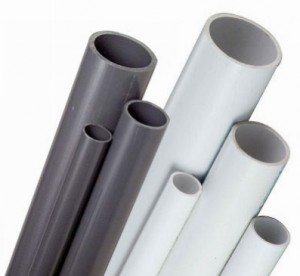
Schedule 40 vs Schedule 80 PVC
Wall Thickness
There are two common types of PVC pipe – schedule 40 PVC and schedule 80 PVC. Schedule 40 PVC is usually white in color and schedule 80 is usually a dark gray (they can also be found in other colors). Their most important difference, though, is in their design. Schedule 80 pipe is designed with a thicker wall. This means the pipe is thicker and stronger, and as a result it can handle higher pressures.
You are probably most familiar with schedule 40 PVC pipe. It’s the white pipe you see used for drainage around buildings, and it can be found in local hardware stores. This pipe is best suited for drainage, irrigation, and other cold water systems. Schedule 40 PVC pipe is strong, rigid, and can handle pressure applications.
For jobs that require a higher pressurization though, schedule 80 pipe is better suited. Most PVC pipe and fittings have a maximum pressure rating listed so you know what it can handle. Typically this is listed in pounds per square inch or PSI.
The amount of pressure a pipe is rated for varies based on size, but a 4” schedule 80 PVC pipe for instance is rated at 320 PSI while a schedule 40 PVC pipe of the same size is only rated at 220 PSI. You can find schedule 80 pipe used most often in heavy duty commercial and industrial applications.
Pipe manufacturers usually make it gray just to differentiate it from standard schedule 40 PVC (though you should always check the manufacturer markings on the pipe to be sure).
Inside Diameter of Schedule 40 vs Schedule 80
If the pipe were the same color, it would be difficult to tell the difference from the outside. In fact, both schedule 40 and schedule 80 PVC pipe have the same outside diameters. So a 1" size sch 40 PVC pipe has the same O.D. as a 1" sch 80 PVC pipe.
The difference is in the inside diameter or I.D. of the pipe. Schedule 80 PVC pipe will have a smaller inside area than Schedule 40 pipe because of its thicker wall. For that reason, flow is more restricted in Schedule 80 pipe vs Schedule 40 of the same size. The same is true of PVC fittings in both schedules.
Weight & Price
Two other factors that may play into which schedule PVC you choose are weight and price. Since schedule 80 PVC has a thicker wall, it is heavier than comparable schedule 40 pipe and fittings. That generally makes it more pricey to ship and more difficult to handle when installing large size pipe and fittings. Schedule 80 PVC is also more expensive than schedule 40 because it requires more PVC material and has to withstand higher pressures.
Other Schedules & Materials
PVC is most commonly found in schedule 40 and 80, but schedule 120 PVC pipe exists also. This is an even thinner wall pipe than schedule 40. These schedules are applied to other materials, too. For instance you can buy schedule 40 and 80 CPVC pipe and fittings. Most manufacturers use different colors like light gray to differentiate this material from PVC. Aside from plastic pipes, schedule is also used to describe metal piping like steel.
Which to Use - PVC or CPVC?
So, if you’re planning to run a high pressure or industrial pipe line, schedule 80 PVC may be a good choice for your project. If not, schedule 40 PVC is more than enough for many pressurized and non-pressurized jobs. Schedule 40 PVC is also relatively inexpensive which makes it great for non-plumbing applications like a PVC pool chair or science project.
Don't forget your fittings come in both schedules also! That means all the tees, elbows and couplings come in both schedule 40 and schedule 80 options. Though schedule 40 and 80 fittings will fit on pipe of either schedule, we recommend you use schedule 40 fittings with schedule 40 pipe and vice versa. A pipeline is only as strong as its weakest link - the part or pipe with the lowest pressure rating.


























































